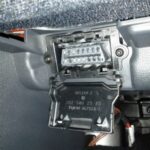Have you ever experienced your car alarm randomly going off, leaving you puzzled and frustrated? If you’re using an OBD2 port accessory, like a diagnostic scanner or a performance gauge, this might be the unexpected culprit. Many car owners are unaware that these devices, plugged into the OBD2 port, can sometimes trigger the factory-installed car alarm system. Let’s delve into this phenomenon, specifically focusing on how “Car Alarm Obd2 Port” interactions can lead to these issues and what you can do about it.
The Mystery of the Triggered Car Alarm and OBD2 Port
One car enthusiast with a 2017 Audi S3 encountered a perplexing problem after installing a P3 gauge, which uses the OBD2 port to display vehicle data. Shortly after installation, the car alarm began to activate sporadically when the car was locked. Through careful troubleshooting, they discovered a peculiar pattern: double-locking the car in quick succession with an OBD2 device plugged in reliably set off the alarm.
This wasn’t a one-off incident. Testing with a BlueDriver Bluetooth OBD2 scanner yielded the same results. The alarm wouldn’t trigger with a single lock, or if there was a longer pause between locking attempts. This issue only surfaced due to the habit of double-checking the car was locked, a common practice for peace of mind. Normally, a second press of the lock button on the key fob would simply elicit a beep confirmation on the Audi S3. However, with an OBD2 accessory connected, this second lock press became the alarm trigger.
Possible Explanations: OBD2 Port Security and Your Car Alarm
The most plausible theory revolves around the car’s security system and its interaction with devices connected to the OBD2 port. It’s speculated that modern vehicles, like the Audi S3, may incorporate some form of OBD2 port monitoring as part of their anti-theft system.
Here’s a potential scenario:
-
Initial Arming: When you lock your car the first time, the alarm system engages. Simultaneously, the OBD2 accessory might initiate a brief data request, draw power, or send a signal through the OBD2 port. This initial action might be within acceptable parameters for the car’s system.
-
Second Arming and Alarm Trigger: When you quickly lock the car a second time, the security system re-arms. This subsequent arming, occurring shortly after the OBD2 device’s initial activity, could be interpreted by the car’s security system as an anomaly or a potential security breach. The system might perceive the ongoing communication or power draw from the OBD2 port during the second arming as unauthorized, thus triggering the alarm as a precautionary measure.
This theory suggests that the car’s alarm system is sensitive to activity on the OBD2 port, especially when the system is being armed or re-armed. The “car alarm obd2 port” interaction becomes problematic when the timing of the locking sequence coincides with the operation of the plugged-in device.
Is This a Common Issue? OBD2 Port and Aftermarket Accessories
While not widely documented, instances of OBD2 accessories triggering car alarms aren’t entirely unheard of. Online forums and discussions reveal similar experiences, particularly with brands like BMW and accessories like the Valentine 1 radar detector, which also utilizes the OBD2 port for power and data.
This suggests that some vehicle manufacturers have incorporated OBD2 port monitoring into their security systems, although the sensitivity and specific triggers may vary between makes and models. The increasing complexity of car electronics and the integration of various systems likely contribute to these unexpected interactions between “car alarm obd2 port” devices and the car’s factory alarm.
What Can You Do? Solutions for OBD2 Port Alarm Issues
If you’re facing the same issue of your car alarm being triggered by an OBD2 port accessory, here are a few potential solutions:
-
Single Lock Only: The simplest workaround, if practical for your security habits, is to only lock your car once. Avoid double-locking, especially in quick succession, as this seems to be the primary trigger.
-
Disconnect OBD2 Accessory: When parking and locking your car, especially for extended periods, consider unplugging the OBD2 accessory. This eliminates the potential interaction between the device and the car’s alarm system.
-
Check Accessory Settings (if applicable): Some OBD2 accessories may have configurable settings related to power consumption or data transmission frequency. Consult the device’s manual to see if adjustments can be made to minimize potential conflicts with the car’s security system.
-
Consult a Mechanic or Dealer: If the issue persists or is significantly disruptive, seek advice from a qualified mechanic or your car dealership. They may have more specific insights into your car’s security system and potential compatibility issues with OBD2 devices.
Understanding the potential link between “car alarm obd2 port” accessories and false alarms can save you from unnecessary stress and ensure your car’s security system functions as intended. While convenient, these plug-and-play devices can sometimes introduce unexpected complexities that require a bit of troubleshooting to resolve.
